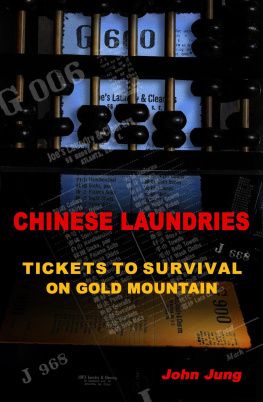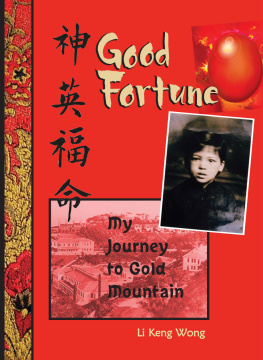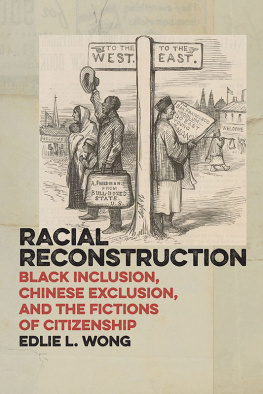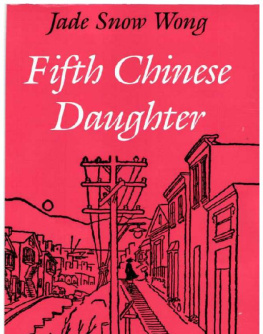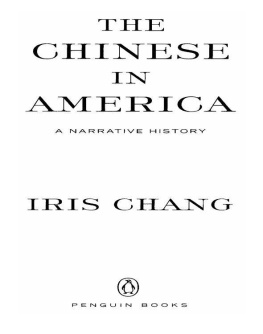ESCAPE TO GOLD MOUNTAIN
Copyright @ 2012 by David H.T. Wong
All rights reserved. No part of this book may be reproduced in any part by any meansgraphic, electronic, or mechanicalwithout the prior written permission of the publisher, except by a reviewer, who may use brief excerpts in a review, or in the case of photocopying in Canada, a license from Access Copyright.
ARSENAL PULP PRESS
Suite 101 211 East Georgia St.
Vancouver, BC V6A 1Z6
Canada
arsenalpulp.com
The publisher gratefully acknowledges the support of the Canada Council for the Arts and the British Columbia Arts Council for its publishing program, and the Government of Canada (through the Canada Book Fund) and the Government of British Columbia (through the Book Publishing Tax Credit Program) for its publishing activities.
Cover illustration by David H.T. Wong
Book design by Gerilee McBride
Editing by Susan Safyan
Printed and bound in Canada
Library and Archives Canada Cataloguing in Publication:
Wong, David H. T., 1959
Escape to gold mountain [electronic resource] : a graphic history of the Chinese in North America / David H.T. Wong.
Includes bibliographical references. Electronic monograph issued in EPUB format. Also issued in print format. ISBN 978-1-55152-477-1
1. ChineseCanadaHistoryComic books, strips, etc. 2. ChineseCanadaHistoryJuvenile literature. 3. ChineseUnited StatesHistoryComic books, strips, etc. 4. ChineseUnited StatesHistoryJuvenile literature. 5. Graphic novels. I. Title.
FC106.C5W65 2012 j971.0049510222 C2012-905206-X
Knowledge is not knowledge, unless it is shared.
My grandmas favourite saying
David! Stop drawing on the walls! When you grow up, you had better still not be drawing cartoons!
My grandmas second favourite saying

Contents
Imogene L. Lim
Connie C. So
Bettie Luke
This graphic novel is dedicated to those early Chinese men and women who came across the Pacific and helped build our nations America and Canada.
Initially, this book was going to explore the history of the Chinese in Canada, but it soon became apparent that sharing only part of the story gave an incomplete picture of the Chinese experience in Gam Saan (Gold Mountain).
And racism knows no boundaries.
The early Chinese did not differentiate between Canada and the United States. They traveled to where they believed there were opportunities and had kin, and to where they were allowed in. The new continent was one; it was Gam Saan, the strange new land.
Our pioneering ancestors were subjected to incredibly harsh discrimination and unspeakable atrocities from ordinary folks and from legislated racism. Institutional racism included the Chinese Exclusion Act of 1882 (US), the Head Tax (Canada, 1885 1923), and the Chinese Immigration Act of 1923 (Canada). These laws effectively shut the Chinese out of Gam Saan for decades.
The result of this institutionalized racism on generations of separated families was great hardship and a Chinese community of predominantly aging men in North America.
Written words are important. I wish to add to the written word using my drawings. I hope this presentation of knowledge in a cartoon format will add to our learning experience.
This is the story of one Chinese family, the Wongs, in Gam Saan. It depicts the world our early forebears experienced. I hope this story will help spark an interest in learning about the struggles of one group of people who helped build our new world.
Although a fictional story, Escape to Gold Mountain is based on facts, on my own familys experiences, and was inspired by the many elders and friends Ive been fortunate to meet along my journey of discovery.
I hope you will enjoy reading this book as much as I enjoyed creating it.


Imogene L. Lim, PhD, Professor, Vancouver Island University, Founding Board Member, Chinese Canadian Historical Society of BC
BAM! POWW!! ZAP! KA-BOOOM!!! KLUNK!
The format of the graphic novel is familiar to many as the comic book writ large. Where else do you find word balloons containing dialogue all written in cap letters, as well as onomatopoeia followed by triple exclamation points for punctuation? The classic story follows a hero who is pitted against adversity, endures privations, does battle, and finally overcomes hardships.
Escape to Gold Mountain has all of these elements. It covers the 150-plus years of the history of the Chinese in North America. During the gold-rush days of the mid-1800s, western North America, in particular, was known to the Chinese as Gam Saan or Gold Mountain. When traveling to Gam Saan, the Chinese made no distinction specifically between Canada and the United States. As a history and as a graphic novel, this book is unique in providing parallel stories of the Chinese in both countries.
If your family was part of the first wave of Chinese immigration, the story in this book is yours, too. It is also personalized by being told through one family over five generations. Imagine your great-great-great grandfather arriving in Gam Saan and facing adversity solely for being Chinese, while today you have the full rights of citizenship. Escape to Gold Mountain takes you from the nineteenth century into the twenty-first, giving voice and face to various characters, from politicians to the common man and woman, placing their lives in the context of the time that began with restrictive legislation.
The histories of the Chinese in the US and Canada are similar yet different, affected by their respective governments policies on immigration and the resultant legislation. In the United States, Chinese were excluded in 1882. Rather than outright exclusion, Canada created barriers to discourage Chinese immigration. When the US Exclusion Act came into force, Chinese labor was still needed to build the Canadian Pacific Railway, if it was to be completed on schedule. One of British Columbias stipulations for joining Confederation was the promise of being linked by rail to the rest of the country. This nation-building task was completed in 1885the same year that Canada implemented a head tax of $50 on Chinese immigrants and which increased to $500 in 1903; the Chinese were the only immigrant group who paid such a fee or tax. In 1923 Canada passed its own Chinese Exclusion Act.
These various acts affected Chinese abroad and those already here. At $500, the cost of immigration to Canada in 1903 was prohibitive; the amount was equivalent to two years wages or the price of a house lot in Vancouver. The result was a community primarily of men. Those who could afford to bring wives and have families were relatively few in number. In many cases, families were separated, with wife and child(ren) in China and husband in Gam Saan. During the period of exclusion, 192347, fewer than fifty Chinese immigrated to Canada.
Even if born in Canada, Chinese were not citizens of the Dominion of Canada until 1947. Section 18 of the Chinese Exclusion Act of 1923 required anyone of Chinese origin or descent in Canada, irrespective of allegiance or citizenship to register with the Chief Controller of Chinese Immigration within twelve months of the Act to obtain a certificate. Without it, the individual could be fined $500 and/or be jailed for a year. My mother, born in Vancouver, BC, held registration certificate #18620 (dated June 20, 1924), while my father, born in Cumberland, BC, was #6278 (dated March 17, 1924); they were six- and five-years old, respectively. On each certificate was written: This certificate does not establish legal status in Canada.
Next page

